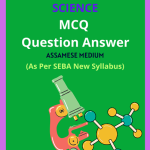Class 8 Science MCQ Chapter 3 Synthetic Fibres and Plastics Solutions in English Medium, Class 8 Science Multiple Choice Question Answer in English to each chapter is provided in the list so that you can easily browse throughout different chapters Class 8 Science MCQ Chapter 3 Synthetic Fibres and Plastics Notes and select need one.
Class 8 Science MCQ Chapter 3 Synthetic Fibres and Plastics
Also, you can read the SCERT book online in these sections Class 8 Science Objective Type Solutions by Expert Teachers as per SCERT (CBSE) Book guidelines. These solutions are part of SCERT All Subject Solutions. Here we have given Assam Class 8 Science MCQs Solutions in English for All Subject, You can practice these here.
Synthetic Fibres and Plastics
Chapter – 3
| MCQ |
1. The plastic used for making water pipes:
(a) Melamine.
(b) PVC.
(c) Polyester.
(d) Bakelite.
Ans: (b) PVC.
2. Which of the following is a bad conductor of electricity?
(a) Plastic.
(b) Copper.
(c) Steel.
(d) Brass.
Ans: (a) Plastic.
3. A chain of small chemical units combined to form a large single unit is called.
(a) Polymer.
(b) Poly.
(c) Polythene.
(d) None of the above.
Ans: (a) Polymer.
4. Polythene and PVC are examples of:
(a) Biodegradable substance.
(b) Thermosetting plastics.
(c) Thermoplastics.
(d) Rayon.
Ans: (c) Thermoplastics.
5. Plastics which when moulded once, cannot be softened by heating. Such plastics are called.
(a) Polythene.
(b) Thermoplastics.
(c) Polyester.
(d) Thermosetting plastics.
Ans: (d) Thermosetting plastics.
6. Polycot is made by mixing two types of fibres namely.
(a) Silk + Cotton.
(b) Polythene + cotton.
(c) Silk + Polyester.
(d) Polyester + Cotton.
Ans: (d) Polyester + Cotton.
7. The 4 R Principle is:
(a) Reduce, Reuse, Recycle, Recover.
(b) Remember, reduce, Recycle, Rejoice.
(c) Repeat, Rejoice, recycle, reduce.
(d) None of the above.
Ans: (a) Reduce, Reuse, Recycle, Recover.
8. Which of the following is Non-biodegradable:
(a) Woollen clothes.
(b) Plastic bag.
(c) Cotton cloth.
(d) Wood.
Ans: (b) Plastic bag.
9. Bakelite and Melamine are examples of:
(a) Thermosetting plastics.
(b) Silk.
(c) Nylon.
(d) Rayon.
Ans: (b) Silk.
10. Fire proof plastic uniform worn by firefighters has a coating of ______________ to make it fire resistant.
(a) Nylon.
(b) Rayon.
(c) Melamine plastic.
(d) Silk.
Ans: (c) Melamine plastic.
11. The coating on modern non- stick cookware and electric iron is of:
(a) Terrycot.
(b) Rayon.
(c) Polyester.
(d) Teflon.
Ans: (d) Teflon.
12. Which of the following is a natural fibre?
(a) Wool.
(b) Nylon.
(c) PVC.
(d) Polythene.
Ans: (d) Polythene.
13. Which of the following is a characteristic of plastics?
(a) Electrical conductors.
(b) Heat conductors.
(c) Biodegradable.
(d) Non-biodegradable.
Ans: (d) Non-biodegradable.
14. Pick The Synthetic Fibre Out Of The Following:
(a) Cotton.
(b) Nylon.
(c) Jute.
(d) Wool.
Ans: (b) Nylon.
15. Which of the following are made from thermosetting plastic?
(a) Bottles.
(b) Crockery.
(c) Shoes.
(d) Handbags.
Ans: (b) Crockery.

Hi! my Name is Parimal Roy. I have completed my Bachelor’s degree in Philosophy (B.A.) from Silapathar General College. Currently, I am working as an HR Manager at Dev Library. It is a website that provides study materials for students from Class 3 to 12, including SCERT and NCERT notes. It also offers resources for BA, B.Com, B.Sc, and Computer Science, along with postgraduate notes. Besides study materials, the website has novels, eBooks, health and finance articles, biographies, quotes, and more.




